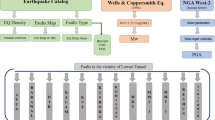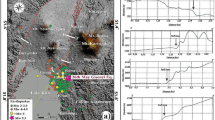Abstract
Turkey, which is one of the countries with high seismic risk, has made significant changes in both seismic risk maps and seismic design codes over time by adapting to these developments. Information about the important changes in the last two earthquake maps and provisions in Turkey was given and the effects of these changes on structural and seismic parameters were examined in this study. In order to make comparisons of seismic parameters, seven different settlements from seven different geographical regions in Turkey were taken into account which have the same seismic risk in the previous earthquake risk map. Seismic moments were also calculated separately for these locations to describe the intensity of future tectonic activity. With the current earthquake hazard map, geographical location-specific earthquake risk has been started to be used instead of regional risk. For the selected settlements with the same seismic risk in the previous map, the seismic risks were found high in some and low in some with the current hazard map. In addition, structural analyses were carried out for the sample reinforced-concrete building with the same structural characteristics in these seven different settlements in order to reveal the effect of the code and map change on the structural analysis. While the target displacements expected from the structures for the settlements with the same seismic risk take the same values, the target displacements are obtained differently for each, since the specific design spectrum is used for each location with the current map.














Similar content being viewed by others
Abbreviations
- A o :
-
Effective ground acceleration coefficient
- BKS:
-
Building usage class
- BYS:
-
Building height class
- DTS:
-
Earthquake design class
- D :
-
Over strength coefficient
- F S :
-
Local ground effect coefficient for 0.2 s
- F 1 :
-
Local ground effect coefficient for 1.0 s
- I :
-
Building importance coefficient
- PGA:
-
Peak ground acceleration
- PGV:
-
Peak ground velocity
- S ae(T):
-
Horizontal elastic spectral acceleration
- S ar(T):
-
The reduced design spectral acceleration
- S(T):
-
Spectrum coefficient
- S DS :
-
Spectral acceleration coefficient for 0.2 s
- S D1 :
-
Spectral acceleration coefficient for 1.0 s
- S S :
-
Map spectral acceleration coefficient for 0.2 s
- S 1 :
-
Map spectral acceleration coefficient for 01.0 s
- R :
-
Structural system behaviour coefficient
- R a(T):
-
Earthquake load reduction coefficient
- T :
-
Natural vibration period
- T A and T B :
-
Corner periods of the horizontal elastic design spectrum
- T AD and T BD :
-
Corner periods of the vertical elastic design spectrum
References
Ademovic, N.; Hadzima-Nyarko, M.; Zagora, N.: Influence of site effects on the seismic vulnerability of masonry and reinforced concrete buildings in Tuzla (Bosnia and Herzegovina). Bull. Earthq. Eng. (2022). https://doi.org/10.1007/s10518-022-01321-2
Alkan, H.; Büyüksaraç, A.; Bektaş, Ö.; Işık, E.: Coulomb stress change before and after 24.01. 2020 Sivrice (Elazığ) Earthquake (Mw= 6.8) on the East Anatolian Fault Zone. Arab. J. Geosci. 14(23), 1–12 (2021). https://doi.org/10.1007/s12517-021-09080-1
Borzi, B.; Faravelli, M.; Di Meo, A.: Application of the SP-BELA methodology to RC residential buildings in Italy to produce seismic risk maps for the national risk assessment. Bull. Earthq. Eng. 19(8), 3185–3208 (2021). https://doi.org/10.1007/s10518-020-00953-6
Işık, E.; Sağır, Ç.; Tozlu, Z.; Ustaoğlu, Ü.S.: Determination of Urban Earthquake Risk for Kırşehir, Turkey. Earth Sci. Res. J. 23(3), 237–247 (2019). https://doi.org/10.15446/esrj.v23n3.60255
Özmen, B.; Pampal, S.: Türkiye Deprem Bölgeleri Haritalarının Evrimi. 4. Uluslararası Deprem Mühendisliği ve Sismoloji Konferansı 11–13 Ekim 2017, Eskişehir
Arasin, İ.B.; Işik, E.; Demirci, A.; Aydin, M.C.: Coğrafi Konuma Özel Tasarım Spektrumlarının Betonarme Yapı Performansına Etkisi. DÜMF Mühendislik Dergisi (2020). https://doi.org/10.24012/dumf.682377
Tabban, A.: Türkiye’nin sismisitesi ve deprem bölgeleri haritasının geliştirilmesi. Türkiye Jeoloji Bülteni 13(2), 36–48 (1970)
Özmen, B.: Türkiye deprem bölgeleri haritalarının tarihsel gelişimi. Türkiye Jeoloji Bülteni, 55(1) (2012)
Işık, E.: A comparative study on the structural performance of an RC building based on updated seismic design codes: case of Turkey. Chall. J. Struct. Mech. 7, 123–134 (2021). https://doi.org/10.20528/cjsmec.2021.03.002
Pampal, S.; Özmen, B.: Türkiye Deprem bölgeleri haritalarının gelişimi. Altıncı Ulusal Deprem Mühendisliği Konferansı, İstanbul-Türkiye, 105–115 (2007)
Büyüksaraç, A.; Isik, E.; Harirchian, E.: A case study for determination of seismic risk priorities in Van Eastern Turkey. Earthq. Struct. 20(4), 445–455 (2021). https://doi.org/10.12989/eas.2021.20.4.445
Eyidoğan, H.; Güçlü, U.: Türkiye deprem bölgeleri haritasının evrimi ve yeni bir harita için öneri/Evolution of Earthquake Zoning Map of Turkey and a Proposal for a New Map. Jeofizik Dergisi, 7(2) (1993)
Gülkan, P.; Koçyiğit, A.; Yücemen, M.S.; Doyuran, V.; Başöz, N.: En son verilere göre hazırlanan Türkiye deprem bölgeleri haritası. Rapor no: METU/EERC, 93–01 (1993)
Kayabali, K.; Akin, M.: Seismic hazard map of Turkey using the deterministic approach. Eng. Geol. 69(1–2), 127–137 (2003). https://doi.org/10.1016/S0013-7952(02)00272-7
Akkar, S.; Azak, T.; Çan, T.; Çeken, U.; Tümsa, M.D.; Duman, T.Y.; Kale, Ö.: Evolution of seismic hazard maps in Turkey. Bull. Earthq. Eng. 16, 3197–3228 (2018). https://doi.org/10.1007/s10518-018-0349-1
Çeken, U.; Dalyan, İ.; Kılıç, N.; Köksal, T.S.; Tekin, B.M.: Türkiye deprem tehlike haritaları interaktif web uygulaması. 4. In Proceedings of the International Earthquake Engineering and Seismology Conference, Bucharest, Romania, 14–17 June 2017
Akkar, S.; EroğluAzak, T.; Çan, T.; Çeken, U.; Demircioğlu, M.B.; Duman, T.; Kartal, R.F.: Türkiye Sismik Tehlike Haritasının Güncellenmesi. UDAP-Ç-13–06). In Ulusal Deprem Araştırma Programı; Disaster and Emergency Management Presidency Press: Ankara, Turkey, http://www.deprem.gov.tr/belgeler2016/tsth.Pdf (2014). Accessed June 22, 2020
Işık, E.; Harirchian, E.; Bilgin, H.; Jadhav, K.: The effect of material strength and discontinuity in RC structures according to different site-specific design spectra. Res. Eng. Struct. Mater 7, 413–430 (2021). https://doi.org/10.17515/resm2021.273st0303
TBEC. Turkish Building Earthquake Code; T.C. Resmi Gazete: Ankara, Turkey (2018)
Alyamaç, K.E.; Erdoğan, A.S.: Geçmişten Günümüze Afet Yönetmelikleri ve Uygulamada Karşılaşılan Tasarım Hataları. Deprem Sempozyumu 23–25 Mart (2007)
Keskin, E.; Bozdoğan, K.B.: 2007 ve 2018 Deprem Yönetmeliklerinin Kırklareli ili Özelinde Değerlendirilmesi. Kırklareli Üniversitesi Mühendislik ve Fen Bilimleri Dergisi 4(1), 74–90 (2018)
TSDC-2007: Turkish Seismic Design Code; T.C., Resmî Gazete: Ankara, Turkey (2007)
Işık, E.; Ekinci, Y.L.; Sayil, N.; Buyuksarac, A.; Aydin, M.C.: Time-dependent model for earthquake occurrence and effects of design spectra on structural performance: a case study from the North Anatolian Fault Zone. Turkey. Turkish J. Earth Sci. 30(2), 215–234 (2021). https://doi.org/10.3906/yer-2004-20
Ulutaş, H.: DBYBHY (2007) ve TBDY (2018) Deprem yönetmeliklerinin kesit hasar sınırları açısından kıyaslanması. Avrupa Bilim ve Teknoloji Dergisi 17, 351–359 (2019). https://doi.org/10.31590/ejosat.620827
Nemutlu, Ö.F.; Balun, B.; Benli, A.; Sarı, A.: Bingöl ve Elazığ İlleri özelinde 2007 ve 2018 Türk deprem yönetmeliklerine göre ivme spektrumlarının değişiminin incelenmesi. Dicle Üniv. Mühendis. Fak. Mühendis. Derg. 11(3), 1341–1356 (2020). https://doi.org/10.24012/dumf.703138
Dalyan, İ; Şahin, B.: Mevcut betonarme bir binanın 2007 ve 2018 deprem yönetmeliklerine göre deprem yükleri altındaki taşıyıcı sistem performansının değerlendirilmesi. Türk Deprem Araşt. Derg. 1(2), 134–147 (2019). https://doi.org/10.46464/tdad.631998
Çaycı, B.T.; Eldemir, O.: TBDY-2018 ve DBYBHY-2007 deprem yönetmelikleri performans seviyelerinin karşılaştırılması. Mühendis. Bilim. ve Tasar. Derg. 9(4), 1386–1397 (2021). https://doi.org/10.21923/jesd.876935
Işık, E.: Comparative investigation of seismic and structural parameters of earthquakes (M ≥ 6) after 1900 in Turkey Arab. J. Geosci. 15, 971 (2022). https://doi.org/10.1007/s12517-022-10255-7
Çetin, K.; Demir, A.; Altıok, T.Y.: 2007 ve 2018 Türk deprem yönetmeliklerine göre yerel zemin sınıflarının yapılardaki burulma düzensizliğine etkisi. Konya Mühendis. Bilim. Derg. 8(2), 282–290 (2020). https://doi.org/10.36306/konjes.578184
Peker, F.Ü.; Işık, E.: TBDY-2018’deki yerel zemin koşullarının çelik yapı deprem davranışına etkisi üzerine bir çalışma. Bitlis Eren Üniv. Fen Bilim. Derg. 10(3), 1125–1139 (2021). https://doi.org/10.17798/bitlisfen.915996
Aksoylu, C.; Arslan, M.H.: Comparative investigation of different earthquake load calculation methods for reinforced concrete buildings in the 2007 and 2019 codes. Int. J. Eng. Res. Devel. 13, 359–374 (2021). https://doi.org/10.29137/umagd.844186
Adar, K.; Büyüksaraç, A.; Işık, E.; Ulu, A.E.: 2007 ve 2018 deprem yönetmeliklerinin yapısal analizler ışığında karşılaştırılması. Avrupa Bilim. ve Teknol. Derg. 25, 306–317 (2021). https://doi.org/10.31590/ejosat.906347
Akyıldız, M.H.; Ulu, A.E.; Adar, K.: TBDY-2018’deki yerel zemin koşullarının deprem kesit tesirlerine etkisi. Dicle Üniv. Mühendis. Fak. Mühendis. Derg. 12(4), 679–687 (2021). https://doi.org/10.24012/dumf.1002217
Albayrak, U.; Morshid, L.A.: Evaluation of seismic performance of steel lattice transmission towers. Civ. Eng. J 6, 2024–2044 (2020). https://doi.org/10.28991/cej-2020-03091600
Ergunes, O.; AksuÖzkul, T.: Seismic assessment of tall buildings designed according to the Turkish Building Earthquake Code. Cıvıl Eng. J. -Tehran 8(3), 567–579 (2022). https://doi.org/10.28991/CEJ-2022-08-03-011
Özmen, B.; Nurlu, M.; Güler, H.: Coğrafi Bilgi Sistemi ile Deprem Bölgelerinin İncelenmesi. Bayındırlık ve İskan Bakanlığı Afet İşleri Genel Müdürlüğü, 89s., Ankara (1997)
Güneş, O.: Turkey’s grand challenge: Disaster-proof building inventory within 20 years. Case Stud. Constr. Mater. 2, 18–34 (2015). https://doi.org/10.1016/j.cscm.2014.12.003
Akansel, V.H.; Soysal, F.; Kadaş, K.; Gülkan, P.: Spektrum şiddeti perspektifinden 2018 Türkiye deprem tehlike haritası değerlendirmesi. Türk Deprem Araştırma Dergisi 2(2), 115–137 (2020). https://doi.org/10.46464/tdad.737433
AFAD (2022) https://tdth.afad.gov.tr. (Accessed 10 January 2022)
Kramer, S.L.: Geotechnical earthquake engineering. Pearson Education India.18TC005365, (1996)
Pejovic, J.; Serdar, N.; Pejovic, R.: Optimal intensity measures for probabilistic seismic demand models of RC highrise buildings. Earthq. Struct. 13, 221–230 (2017). https://doi.org/10.12989/eas.2017.13.3.221
Russo, G.; Marone, G.; Di Girolamo, L.: Hybrid energy piles as a smart and sustainable foundation. J. Human, Earth, Future 2(3), 306–322 (2021)
Aydemir, A.; Ates, A.; Bilim, F.; Büyüksaraç, A.; Bektas, O.: Evaluation of gravity and aeromagnetic anomalies for the deep structure and possibility of hydrocarbon potential of the region surrounding Lake Van, Eastern Anatolia. Turkey. Surv. Geophys. 35, 431–448 (2014). https://doi.org/10.1007/s10712-013-9258-7
Barka, A.A.; Kadinsky-Cade, K.: Strike-slip fault geometry in Turkey and its influence on earthquake activity. Tectonics 7, 663–684 (1988). https://doi.org/10.1029/TC007i003p00663
Ambraseys, N.N.; Melville, C.P.: A history of persian earthquakes, Paperback, p. 219. Cambridge University Press, Cambridge, UK (1982)
Saroglu, F.; Güner, Y.: Dogu Anadolu’nun jeomorfolojik gelisimine etki eden ögeler: Jeomorfoloji, tektonik, volkanizma iliskileri. TJK Bülteni 24, 119–130 (1981)
Kanamori, H.: The energy release in great earthquakes. J Geophy Res. 82(20), 2981–2987 (1977)
Seismosoft: SeismoStruct–A Computer Program for Static and Dynamic Nonlinear Analysis of Framed Structures, http://www.seismosoft.com (2018)
Menegotto, M.; Pinto, P.E.: Method of analysis of cyclically loaded RC plane frames including changes in geometry and non-elastic behavior of elements under normal force and bending. Prelim. Rep. IABSE, 13 (1973)
Mander, B.; Priestley, M.J.N.; Park, R.: Observed stress-strain behavior of confined concrete. J. Struct. Eng. ASCE 114(8), 1827–1849 (1988)
EN 1998–3: Eurocode-8: Design of Structures for Earthquake Resistance-Part 3: Assessment and Retrofitting of Buildings; European Committee for Standardization: Bruxelles, Belgium, (2005)
Pinto, P.E.; Franchin, P.: Eurocode 8-Part 3: Assessment and retrofitting of buildings. In Proceedings of the Eurocode 8 Background and Applications, Dissemination of Information for Training, Lisbon, Portugal, 10–11 February (2011)
Author information
Authors and Affiliations
Corresponding author
Rights and permissions
About this article
Cite this article
Büyüksaraç, A., Işık, E. & Bektaş, Ö. A Comparative Evaluation of Earthquake Code Change on Seismic Parameter and Structural Analysis; A case of Turkey. Arab J Sci Eng 47, 12301–12321 (2022). https://doi.org/10.1007/s13369-022-07099-4
Received:
Accepted:
Published:
Issue Date:
DOI: https://doi.org/10.1007/s13369-022-07099-4




